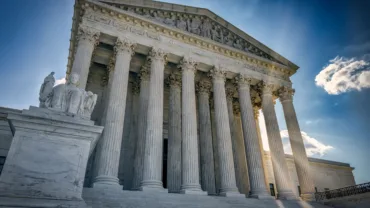It’s never a great day when a major customer of a company files for bankruptcy protection. Most in-house lawyers know, intuitively, that getting paid amounts owed by the customer will be a challenge. But there is so much more that in-house counsel must be aware of when dealing with a debtor in bankruptcy if they expect to properly advise the business on the next steps (or recognize an issue that may require the expertise of outside counsel). This article sets out some of the key things in-house counsel must know when a customer files for bankruptcy protection:
Jump to:
How does bankruptcy work overall?
The role of in-house counsel for the creditor
Bankruptcy checklist for in-house counsel
How does bankruptcy work overall?
When a company’s debts are greater than its assets it becomes “insolvent” and can file for bankruptcy protection. Bankruptcy law is part of a well-defined legal process set out in the US Bankruptcy Code and special rules of bankruptcy procedure (and local rules), all of which both preempt and rely on state law. Bankruptcies are filed and decided in special federal bankruptcy courts before bankruptcy court judges. There are several different bankruptcy chapters each covering different types of debtors and situations, but the most common from a business standpoint are Chapter 7 (liquidation) and Chapter 11 (restructuring).
The role of in-house counsel for the creditor
As a creditor in either situation, it is important to understand that bankruptcy is designed to either get the bankrupt company back in business or ensure it is liquidated in an orderly manner. Regardless of which path is chosen, the process is also designed to ensure that similarly situated creditors are treated the same in terms of a share of the proceeds of sale or as to the plan for reorganization. How the debtor achieves this level of “fairness” is often where in-house counsel (and their business clients) end up back on their heels and scratching their heads.
Practical LawPractice note for an overview, purpose of the US bankruptcy system and more. |  |
What are potential surprises to be prepared for:
Here is a list of the things you need to know about and understand when a customer files for bankruptcy:
The Automatic Stay:
An automatic stay goes into effect with no further action needed on the part of the debtor. The stay halts virtually all collection activities by creditors, i.e., your company, including lawsuits, foreclosure proceedings, and collection calls. There are steep penalties for creditors that violate the stay. It is designed to give the debtor or trustee a chance to take stock of the situation, seek to gather assets of the debtor that can be distributed to creditors and provide for either an orderly liquidation of the company or the creation of a reorganization plan without the hassle of creditor lawsuits or other actions. The fact that collection efforts and lawsuits simply stop, is often a big surprise to in-house counsel.
Proof of Claim:
If the debtor owes you money, you must file a proof of claim setting out the amount owed and, importantly, whether or not the money owed is secured by collateral of some type or, more common, is “unsecured” meaning there is no particular asset of the debtor tied to the repayment of the money owed. As you can imagine, being an unsecured creditor in a bankruptcy is not an envious position. It usually means you can expect to get about ten cents of every dollar owed to the company. This is surprise number two.
Priority of Debts:
To the surprise of many, there is a hierarchy for the payment of debts in bankruptcy. While most in-house counsel know that “secured” debts are generally at the top of the repayment list. But, what follows can be a kick in the shins. Above simple unsecured creditors come certain priority debts, such as tax obligations, tort victims, employee wages, attorneys fees, trustee fees, and so-called “critical vendor” payments. Unsecured debts are literally at the bottom of the barrel and sometimes there is nothing left at all for such parties and they go home empty-handed.
Rejection of Contracts:
In Chapter 11, the debtor has the option to assume or reject certain contracts. These are known as executory contracts (contracts where the parties still have duties to perform) or unexpired leases. Your company, however, must continue to perform under contracts regardless and until the debtor assumes or rejects to deal. If the debtor rejects a contract, it is terminated and no further performance is due by either party. Payment for amounts owed to the creditor under the contract is determined by the priority of debts, meaning you may be performing services for pennies on the dollar. Fortunately, if the debtor assumes the contract then it must cure any default (pre and post-filing for bankruptcy). But, having your contract rejected after several months of waiting and having to perform can be another nasty surprise.
Preference Actions:
To ensure that all creditors are treated as evenly and fairly as possible, bankruptcy law will prevent debtors from favoring certain creditors over others shortly before filing for bankruptcy. These are called “preferences.” Preferences must be paid back to the bankruptcy estate, i.e., you must give back money the debtor paid you already. To qualify as a preference there must (a) be a transfer of the debtor’s property, either money or assets; (b) for the benefit of a specific creditor; (c) on account of an existing debt; (d) made within a certain period before the bankruptcy filing, usually 90 days; that (e) allows the creditor to receive more than they would have received through the bankruptcy distribution process. Remember, as much as it hurts to give the money back, the process is designed reclaim the assets for the bankruptcy estate to distribute them more equitably among all the creditors.
“Free and Clear” Sales:
Last on our list of horribles is what is known as a “Free and Clear” sale by the debtor of property you may have an interest in. In order to gather money for the bankruptcy estate, the trustee or debtor in possession may try to sell certain assets free and clear of any liens, claims, or encumbrances. This can be land, buildings, patents, machines, vehicles, etc. You need to be aware – and seek professional advice – on how to ensure you are notified if a debtor is going to sell something you have an interest in, e.g., selling your proprietary information to a competitor. If you, or your outside counsel, are not on the ball you can end up with some real problems.
Bankruptcy checklist for in-house counsel?
When a customer files for bankruptcy, here is a short checklist of things to do to help ensure you put the company in the best position possible and so that you can educate the business on what to expect with regard to the list above:
- Verify the bankruptcy filing (confirm that the customer has indeed filed for bankruptcy) and the chapter, e.g., Chapter 7 or Chapter 11.
- Gather relevant documentation (collect and organize all relevant documents related to the debt, including invoices, contracts, purchase orders, etc.).
- Determine your creditor status (are you secured or unsecured).
- Consult bankruptcy counsel (depending on the size of your claim or if you find yourself in a preference action).
- Attend creditors’ meetings (stay informed about the progress of the bankruptcy case).
- File a proof of claim (you cannot get paid anything unless you file a proof of claim form).
- Monitor docket to ensure no “free and clear” sales impact your company.
- Observe automatic stay (take care to comply with the stay and refrain from any further collection actions until instructed by the court).
___________________________________________________________________________________
There is much more to the bankruptcy process than outlined above. As a creditor, you are generally in a tough spot and it pays to understand the process and, if necessary, seek the help of experienced counsel. However, if you are an in-house lawyer with Practical Law you have access to an incredible array of content that will help you understand and navigate what’s coming, from tool kits to templates to checklists. It’s all just a click away.















